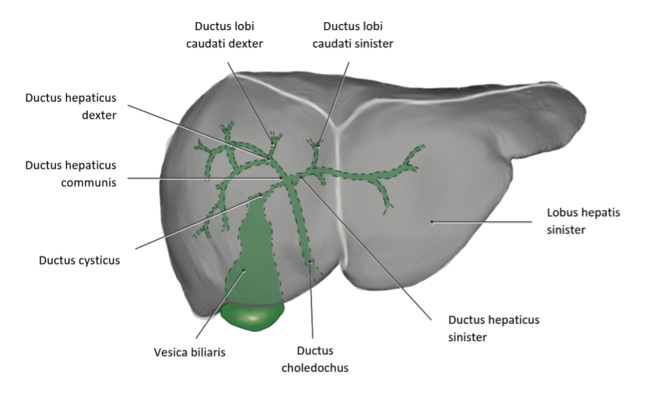Gallenblase (Vesica billiaris)/en: Unterschied zwischen den Versionen
Becher (Diskussion | Beiträge) (Die Seite wurde neu angelegt: „''Further links''“) |
Becher (Diskussion | Beiträge) (Die Seite wurde neu angelegt: „'''Exercises'''“) |
||
| Zeile 49: | Zeile 49: | ||
''Further links'' | ''Further links'' | ||
| − | '''[[Special:MyLanguage/Übungsaufgaben| | + | '''[[Special:MyLanguage/Übungsaufgaben|Exercises]]''' |
[[Special:MyLanguage/Abdomen und Becken|zurück zur Übersicht "Abdomen und Becken"]] | [[Special:MyLanguage/Abdomen und Becken|zurück zur Übersicht "Abdomen und Becken"]] | ||
Version vom 3. Januar 2020, 14:11 Uhr
Inhaltsverzeichnis
Projection of the gall bladder and extrahepatic bile ducts onto the trunk
The mouth of the Ductus pancreaticus lies at the level of the 2nd lumbar vertebral body. In the right medioclavicular line, however, the gall bladder is visible at the lower edge of the 9th rib. Below the costal arch is the gall bladder at the level of the 1st or 2nd lumbar vertebra.
Projection of intra- and extrahepatic bile ducts onto the surface of the liver
Intrahepatic bile ducts
All bile ducts up to the hepatic orifice (porta hepatis) are called intrahepatic bile ducts. Small bile ducts (Canaliculi biliferi) are the bile ducts between the liver cells (hepatocytes). The bile ducts move from the center of a liver lobule to the lobule surface. Here they pass into the short herring ducts (Ductuli biliferi). These again flow into the bile ducts inside the liver lobules (Ductus biliferi interlobulares). They merge into ever larger units and eventually lead to the large intrahepatic liver ducts, the Ductus hepaticus dexter and the Ductus hepaticus sinister.
Extrahepatic bile ducts
Extrahepatic bile ducts are those that are located outside the liver. The ductus hepaticus, which in most cases is outside the liver, proceeds from the left and right hepatic duct near the porta hepatis. The ductus cysticus is one way to store bile in the gall bladder. The ductus choledochus runs in the ligamentum hepatoduodenale to the duodenum. The last section of the ductus choledochus merges with the ductus pancreaticus of the pancreas to form the ampulla hepatopancreatica. This in turn flows through the papilla duodeni major into the duodenum.
Position of the gall bladder in relation to the neighbouring organs
In the "WebViewer" stomach, small intestine, colon transversum, peritoneum in the area of lig. hepatoduodenal are removed and the liver is shown transparent. The gall bladder is firmly connected by the connective tissue of the Fossa vesicae biliaris. The ductus choledochus runs behind the duodenum towards the pancreatic head and through it (not visible in "WebViewer"). Depending on this, the Ductus choledochus either flows together or separately with the Ductus pancreaticus on the Papilla duodeni major in the Pars descendens duodeni.
Structure of the gall bladder and extrahepatic bile ducts
The gall bladder consists of a neck (collum), a body (corpus) and a bladder base (fundus). The Corpus vesicae biliaris enters the neck via the gall bladder funnel. The Ducuts cysticus ( gall bladder duct) attaches to the neck, which leads to the Ductus hepaticus communis. The large bile duct is called ductus choledochus. There the ductus pancreaticus flows, both ducts lead their digestive secretions via the papila duodeni major into the duodenum.
There are further variants of the mouths of Ductus choledochus and Ductus pancreaticus. Gall bladder and ductus cysticus are more rarely doubled. Another variant is an almost completely seperated common ampoule. Also possible is an orifice without a real ampoule and a double orifice of both veins.
(Graphic follows)
Further links

